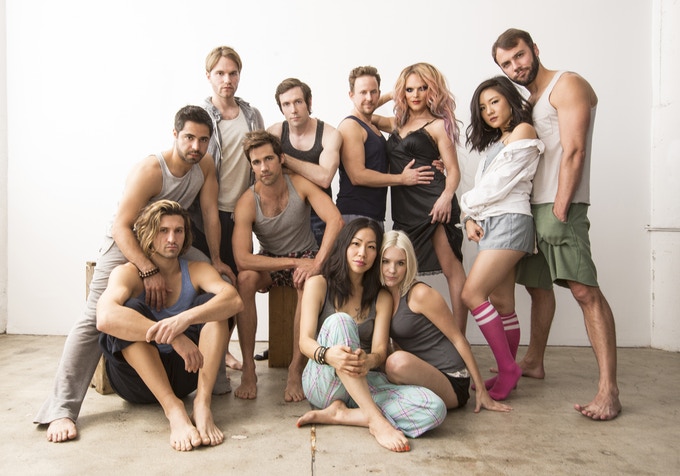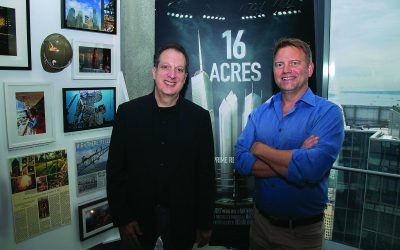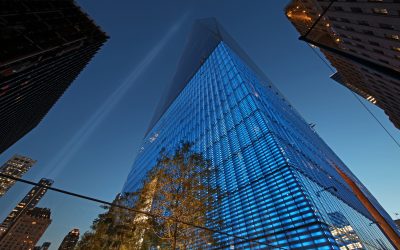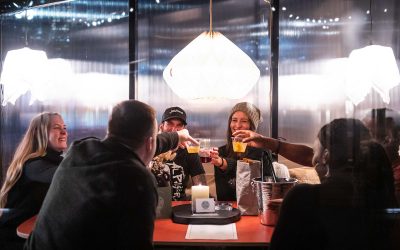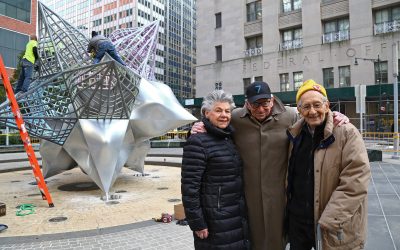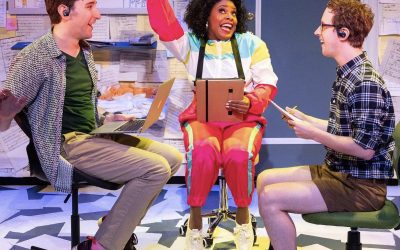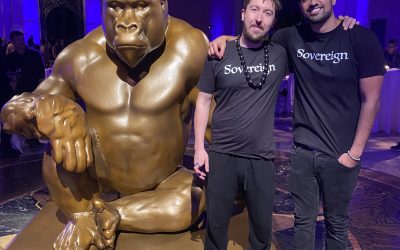From debuting as a web series with its first two episodes uploaded to YouTube back in 2012, Eastsiders has grown into an Emmy-nominated show with a cult following and three darkly twisted yet hilarious seasons with more to come.
Eastsiders is an LGBTQ+, dark comedy series created by Kit Williamson that follows the turbulent and endearing relationship between Thom (Van Hansis) and Cal (Williams) as they grapple with issues from infidelity and trust to roadblocks in their respective careers as a writer and a photographer. The show also branches out to explore the relationships of their Silver Lake, Los Angeles friends, including Kathy (Constance Wu) and her boyfriend Ian (John Halbach) celebrating their six-month anniversary, making it Kathy’s longest relationship but Ian’s shortest and Quincy (Stephen Guarino), a gay club promoter, and Douglas (William Belli), a drag queen, sparking up a dynamic relationship.
This upcoming season will mark the final installment of the series and have the characters confront the hidden truths within their relationships, from answering questions on how love and commitment manifest into a long-term relationship, to examining the challenges of marriage.
Last week, Downtown Magazine attended a special screening for the new season and had the opportunity to sit down and chat with a few members of the cast, discussing the progression of the show since season one and the success found in crowdfunding the entire series.

Downtown: What do you hope your fans and viewers are going to get out of this season?
Kit Williamson: “For me, I hope that people enjoy a fully realized arc. I hope that they feel that every character’s journey is completed. One of the many reasons that this is the final season is that I believe good stories have endings, and I want to leave all of the characters in a not necessarily a happy place, but in the right place for the journey that we’ve seen them go on for the last seven years.”
John Halbach: “I’m so grateful for everyone for following along with us since 2012. And I hope that we can give everyone who’s been so loyal and amazing and supportive, a good, satisfying conclusion for these characters that I love as much as I hope that they do too.”
Van Hansis: “And I also just want to say that like Eastsiders has always been an ensemble show. And the last season, we went on a deep dive into certain relationships. And this one is so much more about, like, Who are these people as a community? And showing so many different types of relationships. It’s a love letter to the show.”
KW: “It’s a love letter to the characters.”
Downtown: “How is the Season 4 storyline and the way you’re ending the series compare and contrast with how you began the storyline originally in Season 1?”
KW: “The characters have grown up a lot over the last seven years, from being just complete and total methods to sort of having their shit together. But just because you have your shit together in your life doesn’t necessarily mean that you’re going to have your shit together in your relationships. And it’s important to depict that, that relationships are hard, no matter what stage of life that you’re in.”
JH: “The ensemble has grown so much. In the beginning, there were five main characters, you know, there’s what 20 main characters now. *laughs* It’s a much bigger, broader world with different stories and different representations and different relationships. It’s really cool patchwork quilt.”
VH: “Yeah, but there’s also a total through line from who these people were in Season 1 to who they are now. Even if like, we haven’t seen some of them for a couple seasons, like coming back into where their lives are now is really exciting. And it’s also exciting to see that like, everybody is different. Jeremy (Matthew McKelligon) is in a place that I never thought he would be in and seeing somebody like him occupy that space is really exciting.”
Downtown: “How have you seen your show fit into this bigger picture of telling queer people’s stories in more nuanced and complex ways?”
KW: “I think being an independently produced series affords us the freedom to tell stories that are a little bit off the beaten path and to represent characters that don’t necessarily fit into an easily understood box. And when you get into depictions of LGBTQ+ characters on network television, especially, they tend to be flattened, one-sided, and often fall into the tropes of respectability politics, with 2.5 kids and a white picket fence in the suburbs, because they’re trying to make these characters palatable to as many people as possible. But the humanity of these characters is just as valid as the humanity of these kinds of characters that I’m talking about. And we need all kinds of representation, we need representation of LGBTQ+ characters that are flawed and complez, and we need to allow them to fuck up their lives and relationships. Because there is catharsis in that. There is validity in that kind of storytelling as well. We need to represent the full spectrum of the human experience, because that’s what we are as LGBTQ+ people, we are every kind of person, we just happen to be LGBTQ+.”
VH: “I would say one thing that’s really amazing about Eastsiders is that our bottom line is so low, because we’re not an expensive show, we’re a very cheap show. We don’t have a lot of money to work with, with that we get to tell our story in a way that I think that if there’s a ton of money behind it, there’s a bottom line that’s higher. And I think that’s why we outlasted shows from fancy networks, because we haven’t taken much to tell the story. And therefore, the risk is less. So for somebody like that, to be behind us, we get to play a little bit more. Which, you know, it sucks that we don’t have the money that we would love to have. But I guess the flip side of that is that because we don’t have money, we get to play.”
JH: “There’s only been a handful of cases really in the history of television. I think that something really special about ours is that you get to see Thom and Cal in a loving, long-term committed open relationship over seven years and I don’t think I can think of another show where you’ve seen that. There’s been a lot of like wacky three-some episodes or it happens once in a thrown-off way.”
VH: *mocking voice* “What did we do?”
JH: “I remember like David and Keith had a three-some on Six Feet Under but it was just one episode.”
KW: “I put a nod to that in Season 2 actually with the coffee scene.”
JH: “So I think that’s something that stands out about Eastsiders.”
Downtown: “How have how have the characters you play on the screen affect your interpersonal relationships in real life?”
KW: “I think everybody assumes that the show is completely autobiographical, which is hilarious because it’s never autobiographical in the ways that people assume it is and often autobiographical in the ways that nobody assumes. Thom and Cal are not Kit and John, but obviously, as this visible gay couple making this gay show people kind of assume that it’s just our life story put on the screen.I don’t know. How has it impacted your life, darling?”
JH: “I don’t know if it has because my character is so close to me. I mean, it’s written for me by my husband so I don’t know that it has. Except in that I love the cast and I love the crew. And we’ve created a family making the show together. So in that way, it certainly has. But I don’t know if it has affected the way that I behaved as a person in the world.”
VH: “I think as far as my character, we actually talked about this, Kit has put a lot of himself into Thom as well. So it’s not like the Kit and John relationship. Like, Tom is the writer. Kit’s a writer, Kit’s the creator. Kit always has a million things in the fire and that’s one of my favorite things about him. But as far as my personal life, I don’t know, I guess the only thing I can think of is I’ve made some friends that I think I’ll have for life, I hope I have for life., You know, being a part of the show and if they share some of their lives with me, based on how they write for me, that’s an honor.”
Downtown: “You’ve had so much success with crowdfunding the entire series of your show, why do you think your show was so successful in doing so? And do you recommend that more shows should be crowdfunded, esp. as it relates to telling more queer narratives?”
KW: “I really recommend crowdfunding for any content creator, but I think that you need to come to the table having produced something independently and self-financed something first, so that you can provide a proof of concept. You’re not just asking for handouts, you’re asking to continue something that you’re already doing. I believe in crowdfunding, especially for projects like ours that are on unlikely to get greenlit by a traditional studio or network. And that’s one of the reasons why I’m continuing my own crowdfunding journey on Patreon. I’m extremely inspired by people like Amanda Palmer who has over 10,000 patrons on Patreon. Willam has over 4,000. You see, these creators who are creating unconventional work get embraced by the crowd because I think that we have a thirst and hunger as an audience, especially as a queer audience, for unique stories. And mainstream media is not known for its uniqueness. They’re known for getting on the bandwagon well after ideas have taken hold in the public consciousness. So for people who try to be on the avante garde, for people who try to innovate and create new ideas and put new ideas out there and really stick their neck out as storytellers, crowdfunding is an amazing place to be. And I am so grateful to have forged, meaningful and lifelong friendships and relationships with people who I met because they were supporters of my work. Like Jen and Jeff Sarabock, who are here today who began as crowdfunding contributors in Season 1 and are now executive producers on the third and fourth season of the show. And now we’ve become close friends. So it’s amazing to just open up your work, your life. You open yourself up to the goodwill of the internet, amazing things can happen.”
Downtown: “Lastly, do you have any advice for any aspiring screenwriters, actors, and anyone wanting to be in the industry to do what you’ve done? Especially as it relates to creatives in New York City?”
JH: “Yeah, I would say to just make something and get it out there. We meet people all the time who say they want to make a show and then wait. You’ve tried to sell it to HBO and try to sell it to Netflix and sit on it. If you can sell it to HBO or Netflix, great and let’s celebrate you. But I think that you’re probably more likely to find success in sharing your story if you just get out there and share it yourself. I mean, I’m so glad that we ended up on Netflix, but we would have not ended up on Netflix if we hadn’t started out on YouTube. And it has been a journey. So I would recommend that, make it and get it out there.”
KW: “Yeah, almost no one sells their first project HBO or Netflix. Almost no one comes out of the gate with the first idea they’ve ever had, the first thing they put pen to paper becoming a televison show. You’ve got to just create and that begets more creation, more success. And I’d say as it pertains to people in New York City, in particular, New York is actually very independent film friendly, very guerilla filmmaking friendly. We have an episode in season three that we shot almost entirely in New York or primarily in New York. And if you’re shooting on a skeleton crew, you don’t actually have to get permits to shoot and a lot of places in New York, you can go out there with a camera operator and a sound mixer and you can make some beautiful art because you have some incredible, timeless, unique places to shoot in New York City. So just get out there and fucking do it. You have no excuse. Your project can look like a Woody Allen film. Not that I’m endorsing Woody Allen. Though, Annie Hall was an important movie for me, I’m not currently endorsing Woody Allen. But I am saying that you can get out there and make things and take advantage of the artistic community in New York City because it’s it’s incredibly vibrant and unlike any other place.”

Seasons 1, 2 and 3 are available for streaming on Netflix right now. Make sure to catch up with the series before the fourth and final season premieres this summer!

